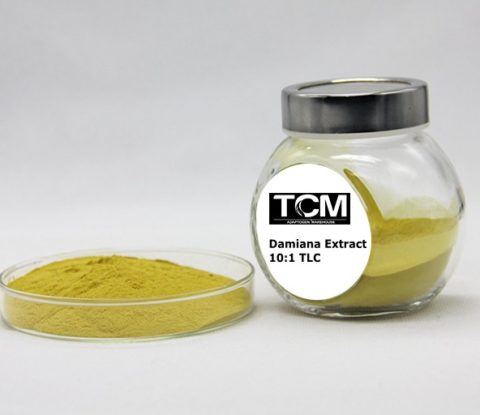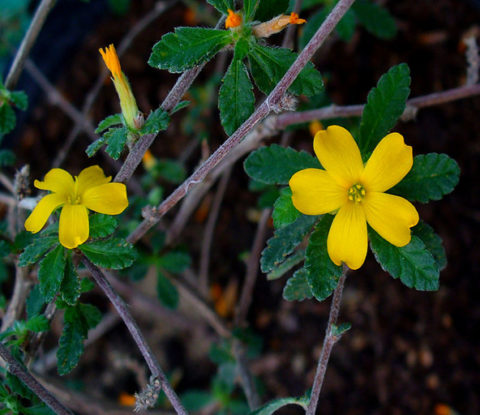
Damiana Extract
【Scientific names】: Turnera diffusa, Turnera aphrodisiaca, Turnera microphylla
【Common names】: Damiana also is known as herba de la pastora, Mexican damiana, old woman's broom, and rosemary (not to be confused with the spice Rosmarinus officinalis)
【Part Used】: Leaves
【Specification】: 5:1; 10:1; 20:1
【Testing Method】: TLC
【Appearance】: Brownish yellow to green Powder
【Particle size】: 100% pass 80 mesh
Brief Introduction
Turnera diffusa, known as damiana, is a shrub native to southern Texas in the United States,Central America, Mexico, South America, and the Caribbean. It belongs to the family Passifloraceae. Damiana is a relatively small, woody shrub that produces small, aromatic flowers. It blossoms in early to late summer and is followed by fruits that taste similar to figs. The shrub is said to have a strong spice-like odor somewhat like chamomile, due to the essential oils present in the plant. Damiana is an ingredient in a traditional Mexican liqueur, which is sometimes used in lieu of triple sec in margaritas. Mexican folklore claims that it was used in the “original” margarita. The damiana margarita is popular in the Los Cabos region of Mexico. Damiana was included in several 19th-century patent medicines, such as Pemberton’s French Wine Coca. The leaves were omitted from that product’s non-alcoholic counterpart, Coca-Cola.
Chemical Composition
Damiana contains damianin; tetraphyllin B; gonzalitosin I; arbutin; tricosan-2-one; acacetin; p-cymene; β-sitosterol; 1,8-cineole; apigenin; α-pinene; β-carotene; β-pinene; tannins; thymol; and hexacosanol. In total, 22 flavonoids, maltol glucoside, phenolics, seven cyanogenic glycosides, monoterpenoids, sesquiterpenoids, triterpenoids, the polyterpene ficaprenol-11, fatty acids, and caffeine have been found in the genus Turnera. As of 2006, damiana’s constituents have not been identified for their effects attributed to the whole herb. Damiana’s anxiolytic properties might be due to apigenin.
Benefits
Traditional Uses
The scientific literature on the plant dates back more than 100 years when reports described its aphrodisiac effects. Damiana history began with its early use by the Maya (under the name mizibcoc) in the treatment of giddiness and loss of balance. Its primary use in the last century has been as an aphrodisiac. Father Juan Maria de Salvatierra, a Spanish missionary, first reported that the Mexican Indians made a drink from the damiana leaves, added sugar and drank it for its love-enhancing properties. In the 1870s, it was imported into the US as a tincture and advertised as a powerful aphrodisiac, to improve the sexual ability of the enfeebled and the aged and to provide increased activity to all the pelvic secretions. Suffice to say that in this patent medicine era, it enjoyed some success.
Damiana was admitted into the first edition of the National Formulary (NF) in 1888 as an elixir and fluid extract. However, it never made it into the US Pharmacopeia and the elixir finally was dropped from the NF in 1916. The fluid extract and the crude drug (leaves) were listed in the NF until 1947. Although some commercial companies continued to sell it to the American market, damiana had almost disappeared until the 1960s “hippy” movement brought it back into popularity.
Aphrodesiac Property
Today, damiana has found its way into a number of herbal OTC products, in particular those claiming to induce a legal herbal “high.” In the Caribbean, damiana leaves are boiled in water and the vapors inhaled for the relief of headaches. Teas are said to aid in the control of bed wetting. No substantive data is available to support the aphrodisiac effects of damiana. Although it has been postulated that the plant may contain the central nervous system stimulant caffeine, the aphrodisiac effect has not been attributed to any specific components. The volatile oil in damiana might be sufficiently irritating to the urethral mucous membranes to account for its so-called aphrodisiac effects. Despite containing a complex mixture of components, there is no evidence to support claims for a hallucinogenic effect.




